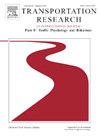Investigating nighttime driver behaviors and interactions at pedestrian Hybrid Beacons
IF 4.4
2区 工程技术
Q1 PSYCHOLOGY, APPLIED
Transportation Research Part F-Traffic Psychology and Behaviour
Pub Date : 2025-07-12
DOI:10.1016/j.trf.2025.07.011
引用次数: 0
Abstract
Pedestrian safety remains a critical concern globally and in the United States. Pedestrian Hybrid Beacons (PHBs) at marked crosswalks have been effective in increasing driver-yielding rates and reducing pedestrian crashes. However, nighttime driver behaviors and social interactions at PHBs, e.g., imitating the behavior of peer drivers, have remained understudied in the post-pandemic context. This study investigates nighttime driver behaviors and explores empirical evidence of social interactions at PHBs following the pandemic. Driver behaviors are collected from videos from four PHB locations in Pima County, Arizona. Descriptive analysis and logistic regression models are used to reveal drivers’ non-compliance rates and interactions with pedestrians and peer vehicles at PHBs at night. Results indicate that 94% to 97% of drivers stopped during the steady red phase of PHBs at night and compliance dropped further to 53% during the flashing red phase. Compared to initial drivers in a platoon approaching during the steady red phase, those approaching during the flashing red phase were approximately 3.6 times more likely to fail to stop. Among leading-following pairs in a platoon (excluding the first vehicles), 50% to 83% of following drivers mimicked the leading vehicle’s behavior, even when the leading driver violated traffic laws. At intersections with a speed limit of 25 mph, 41.7% of drivers resumed travel during the flashing red phase, even when pedestrians were in the crosswalk. These findings provide critical insights into nighttime driver behaviors and social interactions at PHBs. The results can inform improvements in PHB design, implementation, and pedestrian crossing treatments.
调查夜间司机的行为和行人混合信标的互动
行人安全仍然是全球和美国的一个关键问题。在人行横道上设置行人混合信标(PHBs)可以有效地提高驾驶员让行率,减少行人碰撞。然而,在大流行后的背景下,夜间司机的行为和社交互动,例如模仿同行司机的行为,仍然没有得到充分的研究。本研究调查了夜间驾驶行为,并探讨了流行病后PHBs社会互动的经验证据。驾驶员行为从亚利桑那州皮马县四个PHB地点的视频中收集。使用描述性分析和逻辑回归模型揭示夜间phb驾驶员的不合规率以及与行人和同行车辆的互动。结果表明,在夜间phb红灯稳定阶段,有94% ~ 97%的司机停车,红灯闪烁阶段合规率进一步下降至53%。与车队中在红灯稳定阶段接近的初始司机相比,在红灯闪烁阶段接近的司机停车失败的可能性大约是前者的3.6倍。在队列中(不包括第一辆车),50%到83%的尾随司机模仿领头车的行为,即使领头的司机违反了交通法规。在限速为每小时25英里的十字路口,41.7%的司机在红灯闪烁期间恢复行驶,即使行人在人行横道上。这些发现为研究夜间司机的行为和社交互动提供了重要的见解。结果可以为PHB的设计、实施和行人过街处理提供改进信息。
本文章由计算机程序翻译,如有差异,请以英文原文为准。
求助全文
约1分钟内获得全文
求助全文
来源期刊
CiteScore
7.60
自引率
14.60%
发文量
239
审稿时长
71 days
期刊介绍:
Transportation Research Part F: Traffic Psychology and Behaviour focuses on the behavioural and psychological aspects of traffic and transport. The aim of the journal is to enhance theory development, improve the quality of empirical studies and to stimulate the application of research findings in practice. TRF provides a focus and a means of communication for the considerable amount of research activities that are now being carried out in this field. The journal provides a forum for transportation researchers, psychologists, ergonomists, engineers and policy-makers with an interest in traffic and transport psychology.

 求助内容:
求助内容: 应助结果提醒方式:
应助结果提醒方式:


